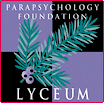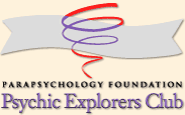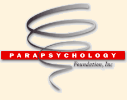 |
 |
| THE BIOGRAPHICAL DICTIONARY OF PARAPSYCHOLOGY MINA STINSON CRANDON (Mrs. Le Roi Goddard Crandon), medium. B. 189-?, Ontario, Canada; m. 1917, Le Roi Goddard Crandon; d. Nov. 1, 1941, Boston, Massachusetts. The most controversial of twentieth centry American mediums, Mina Crandon, known as "Margery," was introduced to spiritualism by her husband, a successful Boston surgeon and a lecturer at Harvard Medical School. Early in 1923, the Crandons attended their first seance and later their private attempts at communication produced table-tilting and a series of raps. These manifestations purported to come from Margery's dead brother, Walter, whose voice eventually asserted itself through the entranced Margery in the phenomenon known as direct-voice mediumship. Dr. Crandon encouraged his wife's mediumship and seances were thereafter held in their house, Margery seated in a seance cabinet built by her husband. Walter, as Margery's "control," manifested his presence in various ways: at one tme it was claimed he stopped all the Crandons' clock; at another he announced that he would play taps, whereupon trumpet noises were heard elsewhere in the house. Soon the "physical" rather than the direct-voice aspects of Margery's mediumship predominated at her sittings. Dr. Crandon claimed to observe "faint, aurora-like" emanations projecting from his wife's fingertips; this inevitably heralded the appearance of ectoplasmic materializations, "disembodied hands" which rang bells, registered thumbprints in wax, and prduced psychic lights which floated about the room. The magazine Scientific American appointed an investigating committee of five persons prominent in psychic research to examine the claims for the Margery phenomena. The secretary of the committee, J. Malcolm Bird (q.v.), published a favorable series of articles in the periodical in 1924, prior to the completion of the investigation. But several months later the committee in its published report revealed that the majority of its members were unconvinced of the genuineness of Margery's phenomena. The famous magician Harry Houdini, a committee member, went further in attacking Margery as a fraud. Her defenders, however, replied that Houdini had not witnessed the bulk of the phenomena, and it was pointed out that the Crandons never undertook sittings for profit; in fact, Dr. Crandon has subsidized much of the investigation. In 1925, another investigation of Margery was undertaken by members of the Harvard faculty who issued a statement that they were "in agreement that the only conclusion possible is that trickery accounted for all teh phenomena; and the only possible difference of opinion is to what extent the trickery is conscious." The wax impressions of Walter's thumbprints were shown to be those of a Boston dentist who admitted making the impression for Mrs. Crandon. The Crandons never replied to the charges implicit in this evidence. Dr. Crandon died in 1939, but his wife continued to practice her mediumship until her death two years later. Although Margery's physical mediumship has been largely discredited (her "emanations" were thought to be animal intestines and human ligaments that could easily have been obtained by Dr. Crandon, but this was never proved), the question of her direct-voice mediumship remains unresolved. In the article "The Witch of Beacon Hill" (Horizon, Jan. 1959), Francis Russell sums up what may be taken as the present-day attitude toward her mediumship: "For Margery to contrive such a conscious Walter fiction during hundreds of sittings over a period of years would be too demanding a feat. Walter was a complete individual. He never hesitated, never lacked for words, never stepped out of character. Rather than to assume that Margery was merely a clever actress, it seems a more likely assumption that her trances at least were genuine and that Walter was a second personality developed in them." The disclosures made in the investigations of the Margery mediumship and perhaps the disillusion that accompanied them had great impact on the subsequent course of psychic research. Spiritualistically oriented enthusiasts who had long influenced its direction began to give way to more scientifically trained investigations, and major attention began to turn from physical phenomena to the study of trance and the various aspects of extrasensory perception. Taken from Helene Pleasants (1964) Biographical Dictionary of Parapsychology with Directory and Glossary 1946-1996 NY: Garrett Publications |
 |

|
 www. parapsychology. org |
||